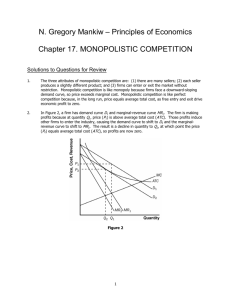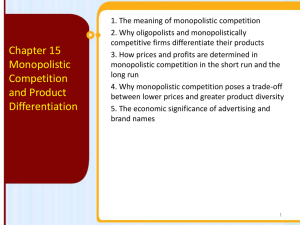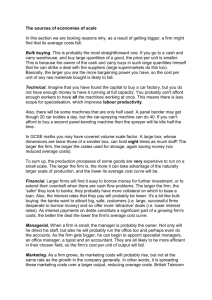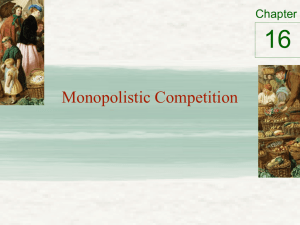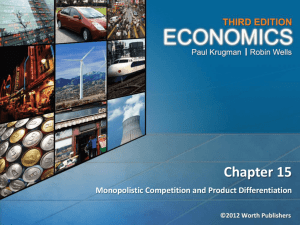Chapter 11 Key Question Solutions
advertisement
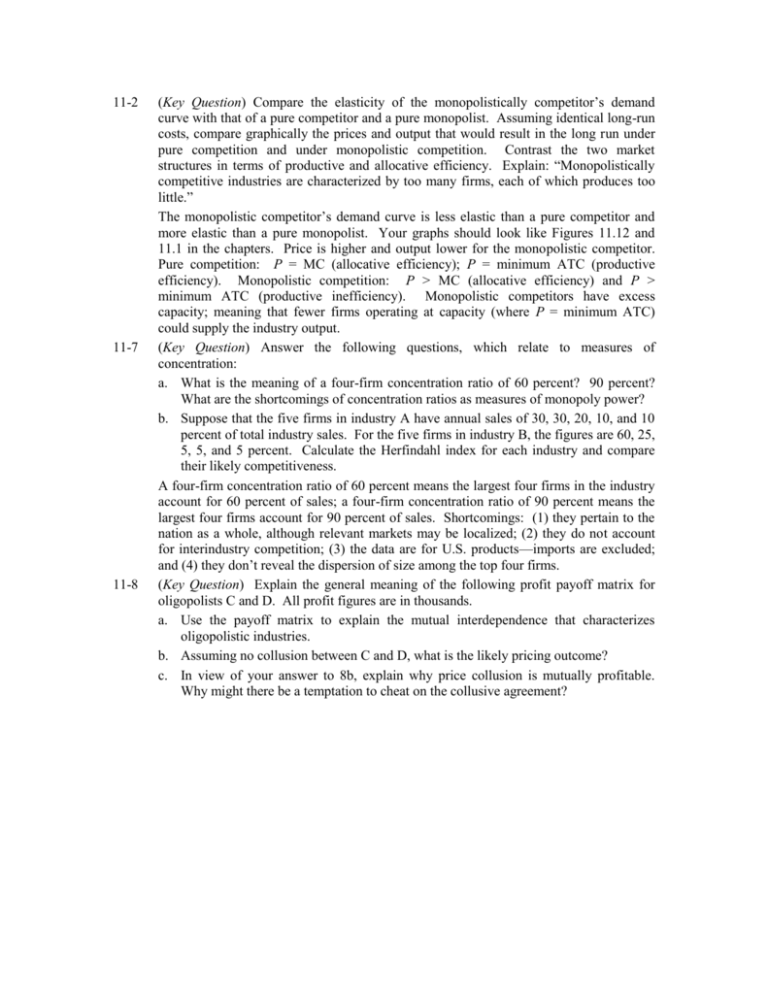
11-2 11-7 11-8 (Key Question) Compare the elasticity of the monopolistically competitor’s demand curve with that of a pure competitor and a pure monopolist. Assuming identical long-run costs, compare graphically the prices and output that would result in the long run under pure competition and under monopolistic competition. Contrast the two market structures in terms of productive and allocative efficiency. Explain: “Monopolistically competitive industries are characterized by too many firms, each of which produces too little.” The monopolistic competitor’s demand curve is less elastic than a pure competitor and more elastic than a pure monopolist. Your graphs should look like Figures 11.12 and 11.1 in the chapters. Price is higher and output lower for the monopolistic competitor. Pure competition: P = MC (allocative efficiency); P = minimum ATC (productive efficiency). Monopolistic competition: P > MC (allocative efficiency) and P > minimum ATC (productive inefficiency). Monopolistic competitors have excess capacity; meaning that fewer firms operating at capacity (where P = minimum ATC) could supply the industry output. (Key Question) Answer the following questions, which relate to measures of concentration: a. What is the meaning of a four-firm concentration ratio of 60 percent? 90 percent? What are the shortcomings of concentration ratios as measures of monopoly power? b. Suppose that the five firms in industry A have annual sales of 30, 30, 20, 10, and 10 percent of total industry sales. For the five firms in industry B, the figures are 60, 25, 5, 5, and 5 percent. Calculate the Herfindahl index for each industry and compare their likely competitiveness. A four-firm concentration ratio of 60 percent means the largest four firms in the industry account for 60 percent of sales; a four-firm concentration ratio of 90 percent means the largest four firms account for 90 percent of sales. Shortcomings: (1) they pertain to the nation as a whole, although relevant markets may be localized; (2) they do not account for interindustry competition; (3) the data are for U.S. products—imports are excluded; and (4) they don’t reveal the dispersion of size among the top four firms. (Key Question) Explain the general meaning of the following profit payoff matrix for oligopolists C and D. All profit figures are in thousands. a. Use the payoff matrix to explain the mutual interdependence that characterizes oligopolistic industries. b. Assuming no collusion between C and D, what is the likely pricing outcome? c. In view of your answer to 8b, explain why price collusion is mutually profitable. Why might there be a temptation to cheat on the collusive agreement? The matrix shows the four possible profit outcomes for each of two firms, depending on which of the two price strategies each follows. Example: If C sets price at $35 and D at $40, C’s profits will be $59,000, and D’s $55,000. (a) C and D are interdependent because their profits depend not just on their own price, but also on the other firm’s price. (b) Likely outcome: Both firms will set price at $35. If either charged $40, it would be concerned the other would undercut the price and its profit by charging $35. At $35 for both; C’s profit is $55,000, D’s, $58,000. (c) Through price collusion—agreeing to charge $40—each firm would achieve higher profits (C = $57,000; D = $60,000). But once both firms agree on $40, each sees it can increase its profit even more by secretly charging $35 while its rival charges $40. 11-9 (Key Question) What assumptions about a rival’s response to price changes underlie the kinked-demand curve for oligopolists? Why is there a gap in the oligopolist’s marginalrevenue curve? How does the kinked demand curve explain price rigidity in oligopoly? What are the shortcomings of the kinked-demand model? Assumptions: (1) Rivals will match price cuts: (2) Rivals will ignore price increases. The gap in the MR curve results from the abrupt change in the slope of the demand curve at the going price. Firms will not change their price because they fear that if they do their total revenue and profits will fall. Shortcomings of the model: (1) It does not explain how the going price evolved in the first place; (2) it does not allow for price leadership and other forms of collusion. 11-11 (Key Question) Why is there so much advertising in monopolistic competition and oligopoly? How does such advertising help consumers and promote efficiency? Why might it be excessive at times? Two ways for monopolistically competitive firms to maintain economic profits are through product development and advertising. Also, advertising will increase the demand for the firm’s product. The oligopolist would rather not compete on a basis of price. Oligopolists can increase their market share through advertising that is financed with economic profits from past advertising campaigns. Advertising can operate as a barrier to entry. Advertising provides information about new products and product improvements to the consumer. Advertising may result in an increase in competition by promoting new products and product improvements. It may also result in increased output for a firm, pushing it down its ATC curve and closer to productive efficiency (P = minimum ATC). Advertising may result in manipulation and persuasion rather than information. An increase in brand loyalty through advertising will increase the producer’s monopoly power. Excessive advertising may create barriers to entry into the industry.
